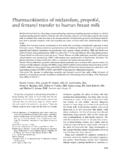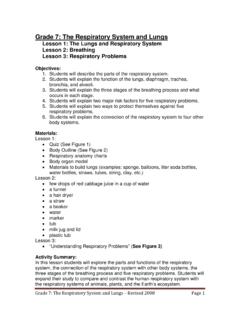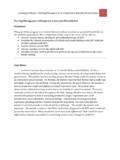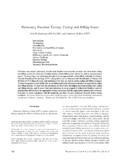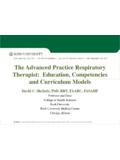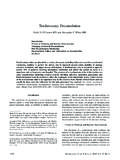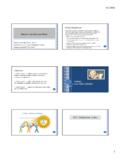Transcription of Peak Flow and Peak Cough Flow in the Evaluation of ...
1 Authors:Adria n Alejandro Sua rez, MDFernando Augusto PessolanoSergio Gabriel Monteiro, PTGabriela Ferreyra, PTMaria Esther Capria, PTLilia Mesa, MDAlberto Dubrovsky, MDEduardo Luis De Vito, MDAffiliations:From the Instituto de InvestigacionesMe dicas Alfredo Lanari, Facultad deMedicina, Universidad de BuenosAires, Argentina (AAS, FAP, SGM, GF,MEC, ELDV), and the HospitalFrance s, Buenos Aires, Argentina(LM, AD).Correspondence:All correspondence and requests forreprints should be addressed toEduardo Luis De Vito, MD, Institutode Investigaciones Me dicas AlfredoLanari, Facultad de Medicina,Universidad de Buenos Aires,Combatientes de Malvinas 3150,Buenos Aires, CP 1427 Journal of PhysicalMedicine & RehabilitationCopyright 2002 by LippincottWilliams & WilkinsPeak Flow and Peak Cough Flow inthe Evaluation of Expiratory MuscleWeakness and Bulbar Impairment inPatients with Neuromuscular DiseaseABSTRACTSua rez AA, Pessolano FA, Monteiro SG, Ferreyra G, Capria ME, Mesa L,Dubrovsky A, De Vito EL: Peak flow and peak Cough flow in the Evaluation ofexpiratory muscle weakness and bulbar impairment in patients with neuro-muscular J Phys Med Rehabil2002.
2 81:506 :To study the expiratory muscle force and the ability to coughestimated by the peak expiratory flow and peak Cough flow in patients withDuchenne muscular dystrophy and amyotrophic lateral :A total of 27 patients with amyotrophic lateral sclerosis and 52patients with Duchenne muscular dystrophy were studied. From the group of144 normal subjects of this laboratory, we selected 38 for :The maximal inspiratory pressure in patients with Duchenne mus-cular dystrophy and amyotrophic lateral sclerosis was , respectively, and maximal expiratory pressure was and , respectively. Patient groups showed a significantlower peak expiratory flow than normal subjects. Higher peak Cough flow thanpeak expiratory flow was found in all groups. The peak Cough flow peakexpiratory flow difference was 46 18% in normal subjects, 43 23% inpatients with Duchenne muscular dystrophy, and 11 17% in patients withamyotrophic lateral sclerosis.
3 The peak expiratory flow and peak Cough flowwere not different in bulbar onset amyotrophic lateral sclerosis. In patientgroups, the dynamic and static behavior correlated :These results suggest that peak Cough flow peak expiratoryflow is useful to monitor expiratory muscle weakness and bulbar involvementand to assess its evolution in these Words:Flow Rate, Peak Expiratory, Cough , Duchenne MuscularDys-trophy, Amyotrophic LateralSclerosis, Neuromuscular Diseases, ExpiratoryMuscle Weakness506Am. J. Phys. Med. Rehabil. Vol. 81, No. 7 Research ArticleNeuromuscular DiseasesWeakness of expiratory musclesis a common and prominent findingin patients with neuromuscular dis-eases and respiratory mucus retention, atelecta-sis, and infection are well known del-eterious effects of inefficient these reasons, the Evaluation ofexpiratory muscles force is importantin these patients.
4 It may be assessedmeasuring the maximal expiratorypressure (MEP) performed against anoccluded airway after a full maneuver is usually ex-tremely difficult to perform in pa-tients with severe weakness of facialmuscles. An acceptable alternative isthe peak flow (PF) determination,which, in absence of bronchial ob-struction, reflects the expiratorymuscle force. Thereby, PF and peakcough flow (PCF) are easier to mea-sure than MEP in patients with bul-bar muscle weakness inDuchennemusculardystrophy(DMD) is the main factor leading torespiratory addition to theexpiratory muscle weakness, bulbarmuscle impairment, such as in amyo-trophic lateral sclerosis (ALS),3pro-vokes inefficient glottis closure withinadequate upper airway protection,leading to aspiration of food or maximal expiratory flow val-ues during a Cough maneuver (PCF)are greater than the classical PF.
5 Thisfact implies an appropriate bulbarfunction (firm glottis closure) thatallows generating high thoracoab-dominal pressure and is expected that the im-paired bulbar function diminishesPCF-PF difference. This differencecould be used as an objective mea-surement of bulbar involvement andits evolution in several neuromuscu-lar diseases. The purpose of this studywas to compare expiratory muscleforce and the ability to Cough , esti-mated by the maximal expiratory flowduring a Cough maneuver, in a pop-ulation of patients with ALS and chil-dren with AND METHODSA total of 27 patients with ALSpatients were enrolled in this diagnosis of ALS was establishedaccording to the El Escorial guide-lines;5all the patients were includedin the category of definite or proba-ble. Patients were divided in bulbar (n 7) or spinal (n 20) onset, accord-ing with the appearance of their 4 of the 27 patients with ALS(17 male patients), more than onestudy (two to five determinations)was carried out within mo(range, 5 26 mo).
6 A total of 36 PF-PCF total of 52 patients with a di-agnosis of DMD were studied. Thediagnosis was established by clinicalcriteria and confirmed by dystrophinimmunostaining. The motor func-tional capacity, according to the clas-sification of Vignos et (score,1 10) was used (score 1, the patientwalks and climbs stairs without assis-tance; score 10, the patient is in awheelchair or bed, elbow flexors lessthan antigravity). A total of 24 pa-tients received deflazacort treatment( 1 mg/kg). In 4 of 52 patientswith DMD, more than one study (twoto three determinations) was per-formed. A total of 57 PF-PCF paireddeterminations were carried total of 144 normal subjects,nonsmokers, asymptomatic, non medical personnel were studied. For-ty-six normal subjects were excludedbecause of a PCF of 800 liters/min(upper limit of the PF meter).
7 Thepatients performed standard spiro-metric tests (Compact II, Vitalo-graph, Buckingham, ). Maximalinspiratory pressure and MEP (Vali-dyne MP 45, Validyne Engineering,Northridge, CA) were performed witha mouthpiece with lipseal. Conven-tional PF and PCF were obtained witha PF meter (Personal Best, normal orlow range). The institutional reviewboard for human study approved theprotocol of this study. All subjectsand their parents were informedabout its nature, and appropriateconsent was inspira-tory pressures and MEP were dis-played on a four-channel polygraphpen recorder (Physiograph MK-IV-P)and stored in a magnetic tape pulse-code-modulation digital recordingadapter (Vetter Digital 4000 A). Thesignals were passed for acquisitionthrough a 16 bit analog to digitalconversion board (Sponge Inc., DataTranslation) at a sampling rate of 60Hz and stored in a personal computerfor future off-line analysis.
8 The signalanalysis was carried out with a soft-ware (Start IS, Canada).Statistical mean val-ues are followed by standard devia-tion of the mean. After testing nor-maldistribution(Kolmogorov-Smirnov test), we chose Wilcoxon ssigned-rank test to assess differencesbetween PF and PCF in the same sub-ject. Mann-Whitney rank-sum testwas used to test differences betweengroups (SigmaStat , Jandel Scien-tific Software, San Rafael, CA). Slopeswere determined by linear regressionanalysis. Differences withP considered significant. Normalvalues of respiratory pressures weretaken from Stefanuti and Fitting7andRochester and the time of this study, patientswith ALS exhibited a wide range ofneurologic deficits. Limb muscleweakness of a single extremity togeneralized muscle weakness withbulbar involvement was percent of the patients werewheelchair users.
9 At the time of thestudy, 66% of patients with spinalonset had bulbar impairment. The es-July 2002 Expiratory Flows in Neuromuscular Diseases507timated duration of disease was definition, glottic closure isnecessary for a Cough . As the bulbarmuscle weakness worsens, coughflows eventually fail to exceed they do not exceed peak expi-ratoryflows, it is because of partial ortotal inability to close the , in some patients with ALSwith complete inability to close theglottis, the PCFs are really only mean motor functional capacityin patients with DMD was percent of the 52 childrenwith DMD were ambulatory (func-tional scale, 1 7), and the remainingwere confined to a wheelchair (func-tional scale, 8 10). Our normalgroup was composed of 98 subjects(34 male subjects), the mean age was34 15 yr, mean body weight was 64 14 kg, and mean height was 166 8 cm.
10 The PF and PCF values were481 76 and 692 67, respectively(P ). The PCF-PF difference(percentage of PF) was 46 18%.The maximal inspiratory pres-sure in patients with DMD and ALSwas and cmH2O, respectively; MEP was and cm H2O, respec-tively. Table 1 lists the physical char-acteristics, the forced vital capacity,and the maximal static respiratorypressures (percentage of normal val-ues) in patients with DMD and restriction andrespiratory muscle weakness werethe perform PF comparisons withpatients with ALS and DMD, 38 nor-mal subjects (23 male subjects) wereselected (mean age, 37 20 yr; bodyweight, 68 14 kg; height, 168 9cm) and divided in two groups. ThePF and PCF values (liters per minute)in normal subjects, patients withDMD, and patients with ALS areshown in Table 2. Both patientgroups showed a significantly lowerPF than normal subjects (P ).
